Bio 1, Chapter 12 DNA – Flashcards
Unlock all answers in this set
Unlock answersquestion
What does DNA replication results in? What does semi conservative mean in regards to DNA replication?
answer
DNA replication is considered semi conservative because it produces two DNA strands each with one new strand and one original strand
question
During DNA replication, a DNA strand that has the bases CATTACGGA produces a strand with the bases
answer
GTAATGCCA.
question
Where is DNA located in eukaryotes and prokaryotes
answer
Eukaryotes the nucleus and prokaryotes in the cytoplasm
question
When does DNA replication happen?
answer
DNA replication happens before cell division in the S phase of interphase.
question
How many copies of chromosomes are left after DNA replication?
answer
2
question
____________adds bases to the new strand of DNA
answer
DNA Polymerase
question
Produced images of DNA molecules using X-rays.
answer
Franklin
question
Used X-ray diffraction to take pictures of DNA. 2nd discovery
answer
Franklin
question
Chargaff showed that adenine and thymine were found in equal percentages in DNA, but he did not know this was because of base-pairing. First discovery
answer
Chargaff
question
Figured out the shape of DNA was a double helix and the two strands in DNA ran in opposite directions. 3rd Discovery
answer
Watson and Crick
question
Discovered that weak hydrogen bonds hold the bases together at the center of a strand of DNA and strong covalent bonds hold the backbone of DNA together
answer
Watson and Crick
question
What structural problem prevents adenine from pairing with guanine and cytosine with thymine?
answer
Guanine and adenine would be too long. cytosine and thymine would too short.
question
True or False: Rosalind Franklin contributed to the understanding of DNA by producing images of DNA molecules using X-rays.
answer
true
question
What stores information in a cell?
answer
DNA
question
What makes up a nucleotide of DNA?
answer
deoxyribose + phosphate group + a nitrogenous base such as cytosine, guanine, thymine, adenine
question
What happens when a piece of DNA is missing?
answer
Genetic information is lost
question
DNA makes a good molecule for storing information because
answer
its bases can be joined together in any order, like the letters of the alphabet can be strung to form different words.
question
In what way is DNA like a book?
answer
DNA has stored information, that can be copied and passed on
question
In the Hershey-Chase experiment, what happened to the bacteria that had been infected by viruses that had radioactive DNA, and to the bacteria that had been infected with viruses that had been marked with radioactive proteins?
answer
The bacteria infected with viruses that had radioactive DNA had become radioactive. The bacteria that had been infected with viruses marked with radioactive proteins were not radioactive.
question
Why did Hershey and Chase label the viral DNA with radioactive phosphorous and not radioactive sulfur?
answer
DNA contains phosphorus and no sulfur.
question
What do bacteriophages infect?
answer
Bacteria
question
What is inside a bacteriophage?
answer
Nucleic acids such as DNA and RNA
question
True or False : Griffith's experiments advanced the study of genetics by proving that there is a chemical that contains genetic information that can be passed from one organism to another.
answer
True
question
What happened when Griffith injected mice with the harmless, R-strain bacteria alone?
answer
The mouse lived
question
What would happen if Griffith took some of the bacteria from Experiment 4 in Figure 12-11, grew them on culture plates, killed them with heat, and mixed them with harmless bacteria? How could he test this hypothesis? Refer to study guide for figure.
answer
The harmless bacteria would be transformed into disease-causing bacteria. To test this hypothesis, he could inject the bacteria in to mice and see if the mice develop pneumonia, or he could grow them on plates and observe the colonies that grow.
question
What happened to the bacteria and the mice in experiment 4, in Figure 12-11? refer to study guide for figure
answer
The harmless bacteria were transformed by the heat-killed bacteria, making the harmless bacteria deadly. The mice that were injected with the mixture died.
question
In which experiments in Figure 12-11 do the mice live Refer to study guide for figure
answer
Experiment 2 and 3
question
What process did Griffith identify in the series of experiments in Figure 12-11? Refer to study guide for figure.
answer
Bacterial transformation
question
concluded that DNA was the transforming factor.
answer
Avery
question
Griffith called the process he observed transformation because the _______ bacteria had been transformed.
answer
_____harmless___
question
Which bacteria killed the mice in Griffith's transformation experiment?
answer
The live harmful bacteria (S strain) and the heat-killed, harmful bacteria mixture
question
Process in which one strain of bacteria is changed by a gene or genes from another strain of bacteria.
answer
Transformation
question
kind of virus that infects bacteria
answer
bacteriophage
question
Principle that bonds in DNA can form only between adenine and thymine and between guanine and cytosine.
answer
base pairing
question
Process of copying DNA prior to cell division
answer
replication
question
principle enzyme involved in DNA replication
answer
DNA Polymerase
question
repetitive DNA at the end of a eukaryotic chromosome
answer
telomere



